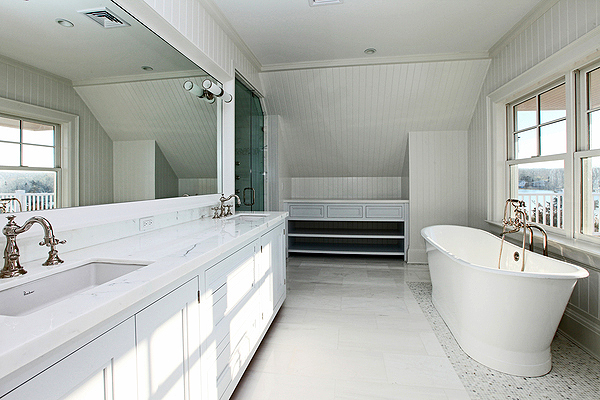
In the dead of winter, there’s nothing like hopping out of a warm shower or bath only to be met by cold bathroom tile.
For those on the East End who can afford the luxuries in life, there is a way around the discomfort: radiant floor heating. But it’s a system that can come at a hefty cost.
On average, a homeowner will spend approximately $2,500 to install radiant floor heating in a 48-square-foot bathroom, according to Edward Maryon, the plumbing service manager at Southampton-based Hardy Plumbing & Heating. The bath is the most popular room for radiant heat floors at East End estates, he added.
“Radiant heat normally works well in smaller, confined areas, although there are instances where it is installed throughout the entire home,” Mr. Maryon explained in a recent email. “It is usually recommended to have a back-up heat on the very frigid days because it takes some time for radiant to heat a residence.”
Radiant systems operate by supplying heat directly to the floor and depend largely on radiant heat transfer—the delivery of heat directly from the hot surface to the people and objects in the room via infrared radiation, according to Rich Patina of Sag Harbor-based Patina Built. Despite its name, Mr. Patina said, radiant floor heating also depends on convection, or the natural circulation of heat within a room as the warm air rises.
“It’s more of a creature comfort than anything else,” Mr. Patina said of radiant floor heating systems during a recent telephone interview. “People love the feeling on their tootsies. It feels good. It’s a nice approach to a comfortable room.”
When considering their options, builders usually choose between two radiant heating methods: electric or hydronic, Mr. Patina reported. The former utilizes either electric cables built into the floor or electrically conductive plastic mats mounted on the sub-floor located below a floor covering, such as tile.
The electric radiant heating method is rarely cost effective, Mr. Patina noted. Hydronic, or liquid-based, systems use very little electricity, he said, and instead depend upon alternative energy sources, such as solar water heaters and gas-, oil- or wood-fired boilers, to pump heated water through tubing laid in a pattern under the floor.
Either way, radiant heating is usually more efficient than forced-air heating because it eliminates duct losses, Mr. Patina said. Also, people with allergies often prefer radiant heat because it doesn’t distribute allergens.
Radiant heating systems do not have the same effect on all floors, though, Mr. Maryon pointed out. They work best when installed under tile, which is a heat conductor and distributes the warmth most efficiently, he said. Wood acts as an insulator, and thus is not as efficient, he added.
“There are aluminium ‘tracks’ that can be installed under the sub-floor for just such applications, but I don’t personally recommend it,” Mr. Maryon said of the process of providing radiant heat for a wood floors.
The comforts of walking on a heated floor are a necessary luxury for many, he continued.
“Most people install radiant heat in entryways, foyers and bathrooms. It’s a comfort to walk into a house, especially during the winter months when it’s cold and snowy and remove your shoes and feel the warm floor. And it will dry out wet shoes quickly,” Mr. Maryon said. “Or coming into a bathroom and have the warm floor to stand on as you are preparing to bathe.”